#dakiniten
Text
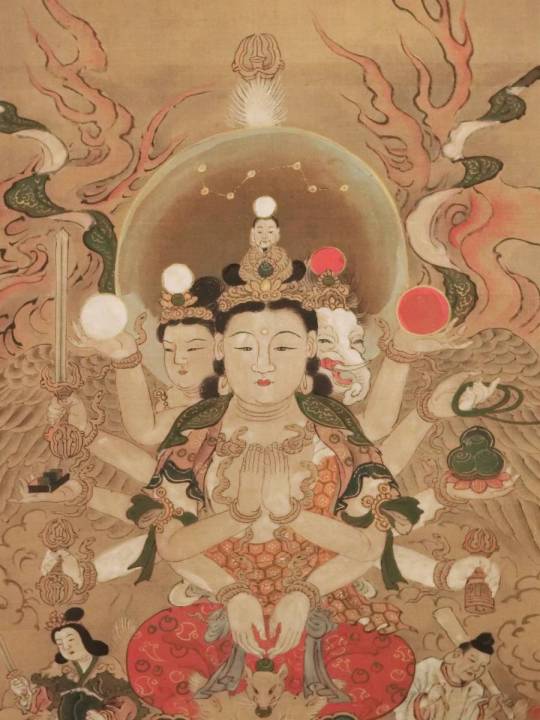
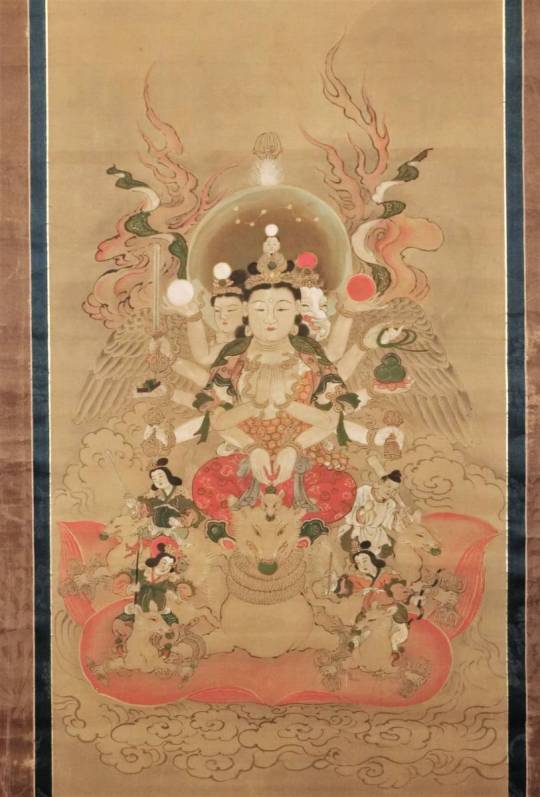
A painted image of the goddess Dakiniten (荼枳尼天), invoked generally for prosperity and fecundity (undated hanging scroll, colors and gold on silk)
Una imagen pintada de la diosa Dakiniten (荼枳尼天), invocada generalmente por la prosperidad y la fecundidad (rollo colgante sin fecha, colores y oro sobre seda)
15 notes
·
View notes
Text
the autistic and spiritual urge to jump down rabbit hole after rabbit hole until im in another dimension all together
#autistic#spiritual#research#rabbit hole#japanese folklore#dakiniten#dakini#kali#shinto#kami#goddess#demon#fox#foxes#inari#syncretism#religion#spirituality#my special interest is everything paranormal/spiritual#reality and fantasy blur#that is where some mysteries and conspiracies ans urban legends come from#most people only go so far before they realize they dont want to know more#i want to know as much as i can#even it breaks my mind#but ive had strange exp since i was a kid
10 notes
·
View notes
Photo

digital portrait of stunning Dakiniten
4 notes
·
View notes
Text
Ayakashi Hyakki Yagyo SR Dakiniten
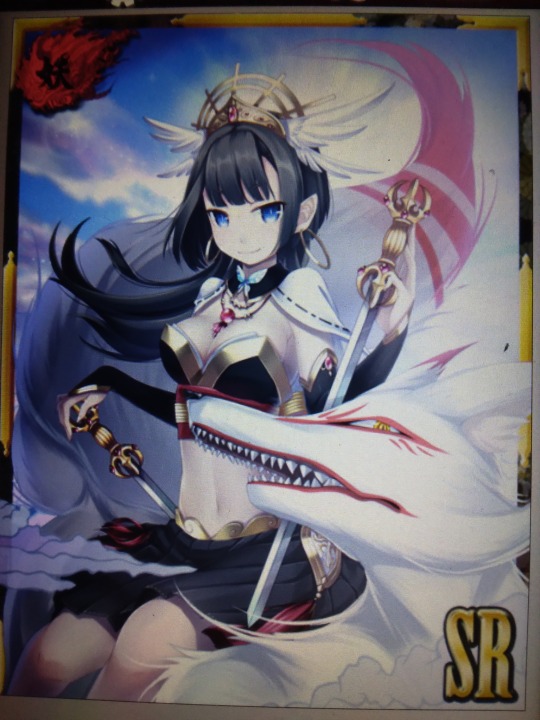
Here is a translation of the description.
``Hmph, do you wish for my blessing, you immature head of Hyakki Yagyo? My blessing is not so cheap that you can receive it casually. Dakuni's blessing is in exchange for your heart. What do you think? Are you prepared to sacrifice your life for that wish?”
[Dakiniten] Dakiniten
A Buddhist deity originating from Hinduism. She has the appearance of a celestial maiden riding a white fox, and is also associated with the Inari faith. She is originally a type of Rakshasa (a general term for demon gods), and has a ferocious nature that devours the hearts of the dead. She is also sometimes interpreted as the god of sexual love.*This card cannot be given as a gift until it reaches SR++. *This card does not have sorcery until it becomes SR++.
1 note
·
View note
Text
Mai, Satono and their peers: a look into the world of dōji

Okay, look, I get it, Mai and Satono are not the most thrilling characters. I suspect they would be at the very bottom of the list of stage 5 bosses people would like to see expanded upon. Perhaps they are not the optimal pick for another research deep dive. However, I would nonetheless like to try to convince you they should not be ignored altogether. If you are not convinced, this article has it all: esoteric Buddhism, accusations of heresy, liver eating, and even alleged innuendos.
As a bonus, I will also discuss a few other famous Buddhist attendant deities more or less directly tied to Touhou. Among other things, you will learn which figure technically tied to the plot of UFO is missing from its cast and what a controversial claim about a certain deity being a teenage form of Amaterasu has to do with Akyuu.
Mai, Satono and the grand Matarajin callout of 1698

An Edo period depiction of Matarajin and his attendants (via Bernard Faure's Protectors and Predators; reproduced here for educational purposes only)
As indicated both by their family names and their designs, Mai and Satono are based on Nishita Dōji (爾子多童子) and Chōreita Dōji (丁令多童子), respectively. These two deities are commonly depicted alongside Matarajin, acting as his attendants, or dōji. Nishita is depicted holding bamboo leaves and dancing, while Chōreita - playing a drum and holding ginger leaves. ZUN kept the plant attributes, though he clearly passed on the drum. In the HSiFS interview in SCoOW he said he initially wanted both of them to hold both types of leaves at once, so I presume that’s when the decision to skip the instrument has originally been made.
We do not actually fully know how Nishita and Chōreita initially developed. It is possible that their emergence was a part of a broader process of overhauling Matarajin’s iconography. While initially imagined as a fearsome multi-armed and multi-headed wrathful deity, with time he took the form of an old man dressed like a noble and came to be associated with fate and performing arts. The conventional depictions, with the attendants dancing while Matarajin plays a drum under the Big Dipper, neatly convey both of these roles. The group was additionally responsible for revealing the three paths (defilements, karma, and suffering) and three poisons (greed, hatred, and desire) to devotees.
In addition to being a mainstay of Matarajin’s iconography, Ninshita and Chōreita also had a role to play in a special ceremony focused on their master, genshi kimyōdan (玄旨帰命壇). This term is derived from the names of two separate Tendai initiation rituals, genshidan (玄旨壇) and kimyōdan (帰命壇).
Genshi kimyōdan can actually be considered the reason why Matarajin is relatively obscure today. In 1698, the rites were outlawed during a campaign meant to reform the Tendai school. It was lead by the monk Reiku (霊空), who compiled his opinions about various rituals in Hekijahen (闢邪篇, loosely “Repudiation of Heresies”). Matarajin is not directly mentioned there, and the polemic with genshi kimyōdan is instead focused on a set of thirteen kōan pertaining to it, with mistakes pointed out for each of them. Evidently this was pretty successful at curbing his prominence anyway, though.
By the 1720s, even members of Tendai clergy could be somewhat puzzled after stumbling upon references to Matarajin, and in a text from 1782 we can read that he was a “false icon created by the stupidest of stupid folks“. He ceased to be venerated on Mount Hiei, the center of the Tendai tradition, though he did not fade away entirely thanks to various more peripheral temples, for example in Hiraizumi in the north. Ironically, this decline is very likely why Matarajin survived the period of shinbutsu bunri policies largely unscathed when compared to some of his peers like Gozu Tennō.
“Nine out of ten Shingon masters believe this”, or the background of the Matarajin callout

Dakiniten (Metropolitan Museum of Art)
Tendai reformers and critics associated genshi kimyōdan with an (in)famous Shingon current supposedly linked with Dakiniten, Tachikawa-ryū. This is a complex issue in itself, and would frankly warrant a lengthy essay itself if I wanted to do it justice; the most prominent researcher focused on it, Nobumi Iyanaga, said himself that “it is challenging to write about the Tachikawa-ryū in brief, because almost all of what has ever been written on this topic is based on a preconceived image and is in need of profound revision”. I will nonetheless try to give you a crash course.
Recent reexaminations indicate that originally Tachikawa-ryū might have been simply a combination of Shingon with Onmyōdō and local practices typical for - at the time deeply peripheral - Musashi Province. Essentially, it was an ultimately unremarkable minor lineage extant in the 12th and 13th centuries. A likely contemporary treatise, Haja Kenshō Shū (破邪顕正集; “Collection for Refuting the Perverse and Manifesting the Correct”) indicates it was met with at best mixed reception among religious elites elsewhere, but that probably boils down to its peripheral character.
Starting with Yūkai (宥快; 1345–1416) Shingon authors, and later others as well, came to employ Tachikawa-ryū as a boogeyman in doctrinal arguments, though. Anything “heretical” (or anything a given author had a personal beef with) could be Tachikawa-ryū, essentially. It was particularly often treated as interchangeable with a set of deeply enigmatic scrolls, referred to simply as “this teaching, that teaching” (kono hō, kano hō, 此の法, 彼の法; I am not making this up, I am quoting Iyanaga); I will refer to it as TTTT through the rest of the article.
These two were mixed up because of the monk Shinjō (心定; 1215-1272) who expressed suspicion about TTTT because of its alleged popularity in the countryside, where “nine out of ten Shingon masters” believe it to be the most genuine form of esoteric Buddhism. However, he stresses TTTT was not only non-Buddhist, but in fact demonic. The description of this so-called “abominable skull honzon”, “skull ritual” or, to stick to the original wording, “a certain ritual” (彼ノ法, ka no hō) meant to prove the accusations is, to put it lightly, quite something.
Essentially, the male practitioner of TTTT has to have sex with a woman, then smear a skull with bodily fluids generated this way over and over again, and finally keep it in warmth for seven years so that it can acquire prophetic powers. This works because dakinis (a class of demons) live inside the skull. The entire process takes eight years because Dakiniten, the #1 dakini, attained enlightenment at the age of 8.
Shinjō himself did not assert TTTT was identical with Tachikawa-ryū, though - he merely claimed that at one point he found a bag of texts which contained sources pertaining to both of them.
Ultimately it’s not even certain if TTTT is real. It might be an entirely literary creation, or an embellishment of some genuine tradition circulating around some marginal group like traveling ascetics. We will likely never know for sure.
Regardless of that, Tachikawa-ryū became synonymous not just with incorrect teachings, but specifically with teachings with inappropriate sexual elements. By extension, it was alleged that the songs and dances associated with Matarajin and his two servants performed during genshi kimyōdan similarly had inappropriate sexual undertones.
ZUN seems to be aware of these implications, since the topic came up in the aforementioned interview. The interviewer states they read that “during the middle ages a lot of Tendai and Shingon sects end up becoming obsessed with sexual rituals and wicked teachings, leading to their downfall” (bit of an overstatement). In response, ZUN explains that these matters are “interesting” and adds that he “did prepare some materials with that, but that would make [the game] too vulgar.” No dialogue or spell card in the game actually references genshi kimyōdan, for what it’s worth, but seeing as this is the only real point of connection between Matarajin and such accusations it’s safe to say ZUN is to some degree familiar with the discussed matter.
As in the case of the Tachikawa-ryū, modern researchers are often skeptical if there really was a sexual, orgiastic component to the rituals, though. A major problem with proper evaluation is that very few actual primary sources survive. We know the words of the songs associated with Matarajin’s dōji, but they are not very helpful. They’re borderline gibberish, “shishirishi ni shishiri” alternating with “sosoroso ni sosoro”. Polemics present them either as an allusion to sex or as an invitation to it; as cryptic references to genitals; or as sounds of pleasure.
None of these claims find any support in the few surviving primary sources, though. Earlier texts indicate that the dance and song of the dōji was understood as a representation of endless transmigration during the cycle of samsara. When sex does come up in related sources, it is presented negatively, in association with ignorance. Bernard Faure argues that the rituals were initially apotropaic, much like the tengu odoshi (天狗怖し), which I plan to cover next month since it helps a lot with understanding what’s going on in HSiFS. The goal was seemingly to guarantee Matarajin will help the faithful be reborn in the pure land of Amida. However, the method he was believed to utilize to that end can be at best described as unconventional.
To unburden the soul from bad karma, Matarajin had to devour the liver of a dying person. This is essentially a positive twist on a habit attributed in Buddhism to certain classes of demons, especially dakinis, said to hunger for so-called “human yellow” (人黄, ninnō), to be understood as something like vital essence, or for specific body parts. In this highly esoteric context, Matarajin was at once himself a sort of dakini, and a tamer of them (usually the role of Mahakala), and thus capable of utilizing their normally dreadful behavior to positive ends.
The true understanding of these actions was knowledge apparently reserved for a small audience, though. Keiran shūyōshū (溪嵐拾葉集), a medieval compendium of orally transmitted Tendai knowledge, asserts that even monks actively involved in the worship of Matarajin were unfamiliar with it.
Beyond Mai and Satono: dōji as a class of deities
You might be wondering why an article which was supposed to be an explanation of Mai and Satono ended up spending so much time on ambivalent aspects of Matarajin’s character instead. The ambivalence present in the aforementioned liver-related belief was a fundamental component of the character of many deities once popular in esoteric Buddhism, and by extension of their attendants too. Therefore, it is actually key to understanding dōji.
As I already mentioned in my Shuten Dōji article a few weeks ago, when treated as a type of supernatural beings, the term dōji implies a degree of ambiguity. The youthfulness of these “lads” means that in most cases they were portrayed as unpredictable, impulsive, eager to subvert social order and hierarchies of power, and prone to hubris. Some of them are outright demonic figures, as already discussed last month. Simply put, they possess the stereotypical traits of a young person from the perspective of someone old. They initially seemingly developed as a Buddhist reflection of Taoist tongzi, in this context a symbol of immortality and youthfulness, though a case can be made that youthful Hindu deities like Skanda (Idaten) also had an influence on this process.
Many Buddhist deities can be accompanied by pairs or groups of dōji, for example Jizō, Kannon, Fudō, Dakiniten or Sendan Kendatsuba-ō. In some cases, other deities could manifest in the form of dōji. In Chiba there is a statue of Myōken reflecting such a tradition, for example. There are also “independent” dōji. Closely related terms include ōji (王子), “prince”, used to refer for example to the sons of Gozu Tennō and the attendants of Iizuna Gongen, and wakamiya (若宮), “young prince”, which typially designates the youthful manifestation of a local deity.In the second half of the article, I’ll describe some notable dōji who can be considered relevant to Touhou in some capacity.
Gohō dōji: the generic dōji and the legend of Myōren

A gohō dōji in the Shigisan Engi Emaki (wikimedia commons)
The term gohō dōji (護法童子) can be translated as something like “dharma-protecting lad”. It’s not the name of a specific dōji, but rather a subcategory of them. Historically they were understood as something like the Buddhist analog of shikigami. The term gohō itself has a broader meaning, and can refer to virtually any protective Buddhist deity, even wisdom kings or the four heavenly kings. The archetypal example of such a figure is Kongōshu (Vajrapāṇi), who according to Buddhist tradition acts as a protector of the historical Buddha.
A good example of a Gohō Dōji is Oto Gohō (乙護法) from Mount Sefuri. He reportedly appeared before the priest Shōkū (性空; 910–1007) before his journey to China, and protected him through its entire duration. Afterwards a temple was built for him. Curiously, this legend actually finds a close parallel in these pertaining to Matarajin, Sekizan Myōjin or Shinra Myōjin protecting monks traveling to China - except the deity involved is a youth rather than an old man.
From a Touhou point of view, the most important example of a gohō dōji is arguably this nameless one, though. He appears in the Shigisan Engi Emaki, an account of the miraculous deeds of the monk Myōren, who you doubtlessly know from UFO. The section focused on him is fairly straightforward: a messenger from the imperial court approaches Myōren because the emperor is sick. Using his supernatural powers, he summons a deity clad in a cape made out of swords to heal him without having to leave his dwelling on Mount Shigi himself. He obviously succeeds. Afterwards the court sends a messenger to offer Myōren various rewards, but he rejects them. While the emperor is not directly shown or named, he is presumably to be identified as Daigo.
While the supernatural helper is left unnamed and is often simply described as a gohō dōji in scholarship, it has been pointed out that his unusual iconography seems to be a variant of that associated with the fifth of the twenty eight messengers of Bishamonten. A depiction of a similar figure is known for example from the Ninna-ji temple in Kyoto. This makes perfect sense, seeing as the connection between Myōren and this deity is well documented, and recurs through the legends presented in the Shigisan Engi Emaki. Needless to say, it is also the reason why Bishamonten by proxy plays a role in the plot of UFO. Given these fairly direct references, I am actually surprised no UFO character borrows any visual cues from the gohō dōji, seeing as the illustration is quite famous. It was even featured on a stamp at one point.
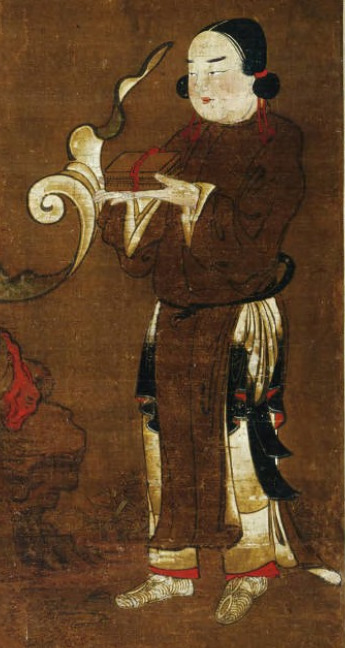
Zennishi Dōji (Princeton University Art Museum; reproduced here for educational purposes only)
Yoshiaki Shimizu has suggested that the connection between Myōren and his Gohō Dōji is meant to mirror that between Bishamonten and his son and primary attendant, Zennishi Dōji (善膩師童子), and highlight that the monk was an incarnation of the deity he worshiped. He also argued that Myōren’s nameless sister (not attested outside Shigisan Engi Emaki) - the character ZUN based Byakuren on - is meant to correspond to Bishamonten’s wife, Kisshōten/Kichijōten (presumably with spousal bond turned into a sibling one). I am not sure if this proposal found broader support, though - I’m personally skeptical.
Kongara Dōji (and Seitaka Dōji): almost Touhou
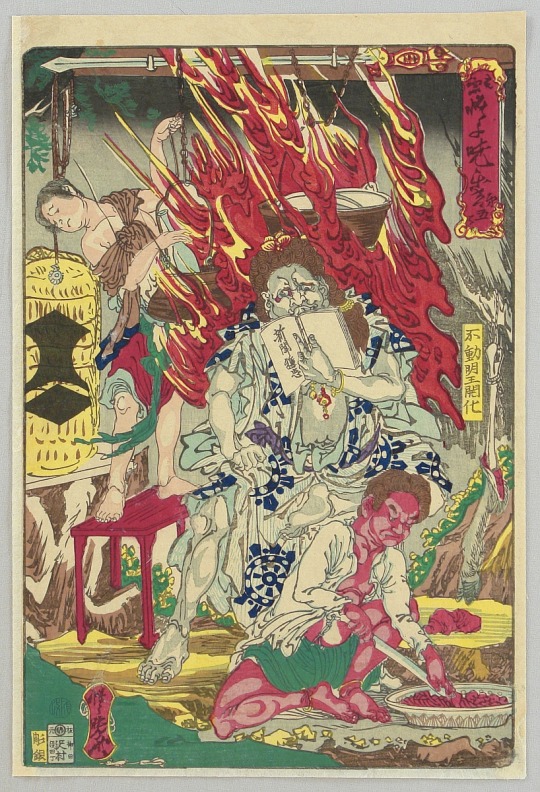
Fudō Myōō, as depicted by Kyōsai (via ukiyo-e.org; reproduced here for educational purposes only)
Kongara Dōji (衿羯羅童子, from Sanskrit Kiṃkara) and Seitaka Dōji (制多迦童子, from Sanskrit Ceṭaka) are arguably uniquely important as far as the divine dōji go - a case can be made that they were the model for the other similar pairs. They are regarded as attendants of Fudō Myōō (Acala), one of the “wisdom kings”, a class of wrathful deities originally regarded as personifications and protectors of a specific mantra or dhāraṇī. In Japanese esoteric Buddhism, they are understood as manifestations of Buddhas responsible for subjugating beings who do not embrace Buddhist teachings.
Acting as Fudō‘s servants is the primary role of Kongara and Seitaka. As a matter of fact, both of their names are derived from Sanskrit terms referring to servitude. This is not reflected in their behavior fully: esoteric Buddhist sources indicate that Kongara is guaranteed to help a devotee who would implore him for help, but Seitaka is likely to disobey such a person. Interestingly, both can be recognized as manifestations of Fudō. This seems to reflect a broader pattern: once a deity ascended to a prominent position in esoteric Buddhism, some of their functions could be reassigned to members of their entourage. ZUN arguably references this in Mai and Satono’s bio, according to which “their abilities (...) are nothing more than an extension of Okina's.”
Despite the aforementioned shared aspect of their nature, Kongara and Seitaka actually have completely different iconographies. Kongara is portrayed with pale skin, wearing a monastic robe (kesa) and with his hands typically joined in a gesture of respect. Seitaka, meanwhile, has red skin, and holds a vajra in his left hand and a staff in the right. His characteristic five tufts of hair are a hairdo historically associated with people who were sentenced to banishment or enslavement. He’s never portrayed wearing a kesa in order to stress that in contrast with his “coworker” he possesses an evil nature. It has been argued the fundamental ambivalence of dōji is behind this difference in temperaments.
While the pair consisting of Kongara and Seitaka represents the most common version of Fudō’s entourage, he could also be portrayed alongside eight (a Chinese tradition) or uncommonly thirty six attendants. The core two are always present no matter how many extra dōji are present, though. Appearing together is essentially their core trait, and probably is part of the reason why they could be identified with other duos of supernatural servants, like En no Gyōja’s attendants Zenki and Gōki (who as you may know are referenced in Touhou in one of Ran’s PCB spell cards, and in a variety of print works).
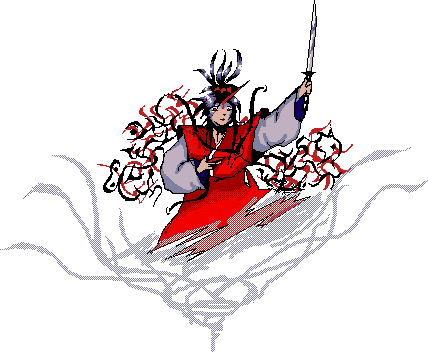
As for the Touhou relevance of Kongara and Seitaka, a character very obviously named after the former appeared all the way back in Highly Responsive to Prayers, but I will admit I am personally skeptical if this can be considered an actual case of adaptation of a religious figure. There are no iconographic similarities between them, and their roles to put it lightly also don't seem particularly similar. Much like the PC-98 use of the term makai (which I will cover next month), it just seems like a random choice.
At least back in the day there was a fanon trend of treating the HRtP Konngara as an oni and a fourth deva of the mountain, but I will admit I never quite got that one. In contrast with Yuugi and Kasen’s counterparts, Kongara's namesake actually doesn’t have anything to do with Shuten Dōji.
The less said about a nonsensical comment on the wiki asserting Kongara’s status as a yaksha (something I have not seen referenced outside of Touhou headcanons, mostly from the reddit/tvtropes side of the fandom) explains why his supposed Touhou counterpart is present in hell, the better.
Uhō Dōji: my life as a teenage Amaterasu protector of gumonji practitioners

Uhō Dōji (Metropolitan Museum of Art)
Uhō Dōji (雨宝童子), “rain treasure child”, will be the last dōji to be discussed here due to being by far the single most unusual member of this category. Following most authors, I described Uhō Dōji as a male figure through the article, but as noted by Anna Andreeva, most depictions are fairly androgynous. Bernard Faure points out sources which seem to refer to Uhō Dōji as female exist too; this is why I went with a gender neutral translation of dōji. In any case, the iconography is fairly consistent, as documented already in the Heian period: youthful face, long hair, wish-fulfilling jewel in one hand, decorated staff in the other, plus somewhat unconventional headwear, namely a five-wheeled stupa (gorintō).
Originally Uhō Dōji was simply a guardian deity of Mount Asama. He is closely associated with Kongōshō-ji, dedicated to the bodhisattva Kokūzō. The latter is locally depicted with Uhō Dōji and Myōjō Tenshi (明星天子), a personification of Venus, as his attendants.Originally the temple was associated with the Shingon school of Buddhism, though today it instead belongs to the Rinzai lineage of Zen.
A legend from the Muromachi period states that Kongōshō-ji was originally established in the sixth century, during the reign of emperor Kinmei by a monk named Kyōtai Shōnin (暁台上人).The latter initially created a place for himself to perform a ritual popularly known as gumonji (properly Gumonji-hō, 求聞持法, “inquiring and retaining [in one’s mind]”).The name Kongōshōji was only given to it later when Kūkai, the founder of the Shingon school of Buddhism (from whose traditions gumonji originates), received two visions - one from a dōji and then another from Amaterasu - that a place suitable to perform gumonji exists on Mount Asama. After arriving there, he stumbled upon the ruins of Kyōtai Shōnin’s temple, so he had it rebuilt and renamed it. Subsequently, Amaterasu appointed Uhō Dōji to the position of the protector of both this location and Buddhist devotees partaking in gumonji in general.
Most of you probably know that gumonji pops up in Touhou as the name of Akyuu’s ability in Perfect Memento in Strict Sense. ZUN describes it simply as perfect memory, but in reality it’s an esoteric religious practice focused on chanting the mantra of Kokūzō 1000000 times over the course of a set period of time (either 100 or 50 days). The goal is to develop perfect memory in order to be able to memorize all Shingon texts, though it is also believed to increase merit and grant prosperity in general. The oldest references to it come from the eighth century, and based on press coverage it is still performed today.
ZUN actually never mentioned gumonji in a context which would stress the term’s Buddhist character. In Forbidden Scrollery Akyuu prays to Iwanagahime rather than to any Buddhist figures. I get the idea behind that, but I will admit I liked the portrayal of her religious activities in Ashiyama’s Gensokyo of Humans much more.

Gumonji aside, the second major point of interest is the connection between Uhō Dōji and Amaterasu. In the legend I’ve summarized above, they are obviously two separate figures, with one taking a subordinate position. This changed later on, though. At some point, most likely between 1419 and 1428, the two deities came to be conflated. As Bernard Faure put it, Uhō Dōji effectively came to be seen as the “Buddhist version of Amaterasu”. To be specific, as Amaterasu at the age of sixteen, presumably to account for the fact that a dōji would by default be a youthful figure.
The treatise Uhō Dōji Keibyaku goes further and asserts that that Uhō Dōji manifests in India as the historical Buddha, Amida and Dainichi; in China as Fuxi, Shennong and Huang Di; and in Japan as Amaterasu, Tsukuyomi and Ninigi. In his astral role, he represents the planet Venus, but he can also manifest as Dakiniten and Benzaiten, in this context understood as respectively lunar and solar. He is also the creator of all of these astral bodies.
The grandiose claims about Uhō Dōji, Amaterasu and other major figures were not exactly uncontroversial. It seems that especially in the eighteenth century the Ise clergy objected to them, presumably because they effectively amounted to their peers at Kongōshō-ji promoting their own deity to make the temple more important as a part of the Ise pilgrimage, which at the time enjoyed considerable popularity.
The association between Amaterasu and Uhō Dōji nonetheless persisted through the Edo period, and despite protests voiced at Ise among laypeople Mount Asama was widely recognized as the third most important destination for participants in the Ise pilgrimage, next to the outer and inner shrines at Ise themselves. It is also quite likely that there was no shortage of people who would imagine Amaterasu looking just like Uhō Dōji.
Ultimately the Uhō Dōji controversy was just one of the many chapters in Amaterasu’s long and complex history, and there was nothing particularly unusual about the claims made. There were quite literally dozens of Buddhist or at least Buddhist-adjacent figures she developed connections to (Bonten, Enma and Mara, to name but a few), and the Ise clergy took active part in this process. Buddhist reinterpretations of Amaterasu flourished especially through the Japanese middle ages.
It was only the era of Meiji reforms that brought the end to this, cementing the Kojiki and Nihon Shoki inspired vision of Amaterasu as the only appropriate one. However, this is beyond the scope of this article. Worry not, though: the very next one I’m working on will cover these matters in detail. Please look forward to it.
Bibliography
Anna Andreeva, “To Overcome the Tyranny of Time”: Stars, Buddhas, and the Arts of Perfect Memory at Mt. Asama
Talia J. Andrei, The Elderly Nun, the Rain-Treasure Child, and the Wish-Fulfilling Jewel: Visualizing Buddhist Networks at the Grand Shrine of Ise
William M. Bodiford, Matara: A Dream King Between Insight and Imagination
Bernard Faure, The Fluid Pantheon (Gods of Medieval Japan vol. 1)
Idem, Protectors and Predators (Gods of Medieval Japan vol. 2)
Idem, Rage and Ravage (Gods of Medieval Japan vol. 3)
Nobumi Iyanaga, Tachikawa-ryū in: Esoteric Buddhism and the Tantras in East Asia
Gaétan Rappo, Heresy and Liminality in Shingon Buddhism: Deciphering a 15th Century Treatise on Right and Wrong
Idem, “Deviant Teachings”. The Tachikawa Lineage as a Moving Concept in Japanese Buddhism
Yoshiaki Shimizu, The "Shigisan-engi" Scrolls, c. 1175
107 notes
·
View notes
Text
A brief look into the Hand seals (印) of Domain Expansions
The hand seal used by Domain expansion users is shirushi (印) or mudra of various bodhisattvas. In normal practice, these seals are performed while chanting the mantra for respective Bodhisattva.
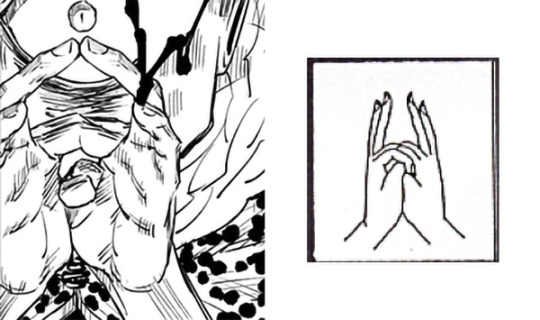
1. Jougo, Domain: Coffin of Iron Mountain (蓋棺鉄囲山 / gaikan tecchizen); seal is associated with Daikokuten.
Also known as Mahakala, or "the Great Black one", or "the Great Time", Daikokuten is originated from Shiva in Hinduism, who plays role as the destroyer of all things as per his connection to "time" (kala), whose aspects later adopted by Buddhism. In Japan, Daikokuten is one of the seven lucky gods (七福神 / shichifukujin) associated with food and wealth.
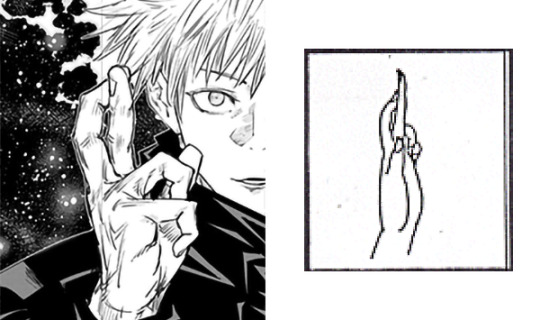
2. Gojou Satoru, Domain: Unlimited Void (無量空処 / muryoukuusho); seal is associated with Taishakuten or Sakra
Sakra means "powerful" or "mighty", and is originated from Indra. Taishakuten is often depicted as a pair with Brahma (or Bonten) as the greatest protector deities (dharmapala) of Buddhism. As Indra governs other devas in heaven, Taishakuten is also depicted to govern other 32 gods in heaven and served by the Four Heavenly Kings (四天王 / shitennou).

3. Ryoumen Sukuna, Domain: Malevolent Shrine (伏魔御厨子 / fukuma mizushi); seal is associated with Enmaten or Yama
Enmaten is more famously known as King of Hell, he is a deity who governs fate, death, and underworld. He passes judgements to soul of people who had died, to send them to the appropriate afterworld. He is often depicted to have fierce expression. He is also the protector deity of south direction.

4. Mahito; Domain: Self-Embodiment of Perfection (自閉円頓裹 / jihei endonka); seals are associated with Kokuuzou bosatsu or Akasagharba and Gigeiten
Kokuuzou bosatsu (虚空蔵菩薩) is known as one of the eight great bodhisattvas, whose wisdom is said to be as vast as the space, hence his association with the space element (虚空 ; kokuu, lit. "empty space"). He is worshipped for wisdom, knowledge, and memory.
On the other hand, Gigeiten is a celestial maiden who governs over entertainment and good fortune. She is said to have been born from the hair of Maheshavara, thus she possesses good looks. She is also a master of various art forms.

5. Fushiguro Megumi, Domain: Chimera Shadow Garden (嵌合暗翳庭 / kangou'an eitei), seal is associated with Bhaisajyaguru or Yakushi Nyorai
Also called as Medicine Buddha, Yakushi Nyorai is known for his twelve vows to attain enlightenment. He aspired to heal people's illnesses, cure diseases, and erase the sufferings of sentient beings. The twelve Heavenly Generals (十二神将 / juuni shinshou) are his followers, originated as yakshas who were converted by his teachings. Hence Makora, or Mahoraga as one of Fushiguro's shikigami.

6. Okkotsu Yuuta, Domain: unknown, seal is associated with Dakini
Dakini is a type of female demon or yakshini. The portrayal of Dakinis vary among beliefs, ranging from flesh-eating female demons, similar to Kali in Hinduism, to goddess associated with constituents of human body. In Japan, the Dakini later were coalesced into a single deity called Dakiniten, who later syncretized with deity Inari, goddess of agriculture, represented by a celestial maiden riding white fox.
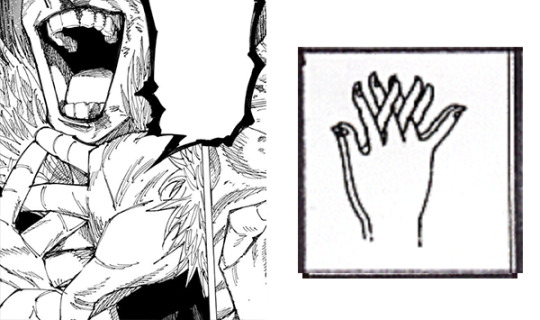
7. Ishigoori Ryu, Domain: unknown, seal is associated with Kujaku Myo-ou or Mahamayuri
Mahamayuri is a female bodhisattva, whose name means "Great Peacock". She is depicted to have three faces and four arms. Because peacock eats poisonous snakes such as cobra and other pests, Mahamayuri became known to be able to protect her followers from pain and disasters. She is also believed to be able to protect people from poisoning, either physically or spiritually.

8. Uro Takako, domain: unknown, seal is associated with Kundali
Also known as Amritankundali, he is a wrathful protector deity regarded as the manifestation Ratnasambhava, who was focused on equality, to destroy greed and pride. He is also said to be manifestation of Akasagarbha. In addition the nectar of immortality is believed to be originated from him.

9. Hakari Kinji, Domain: Idle Death Gambler (坐殺博徒 / zasatsu bakuto), seal is associated with Benzaiten or Saraswati
Benzaiten as one of the seven lucky gods (七福神 / shichifukujin) is worshipped for monetary fortune. She is often depicted playing biwa as goddess of music. Saraswati is also regarded as goddess of river, hence she becomes known as goddess of "all things flow"; water, time, music, eloquence, fortune, and knowledge. Another version of Benzaiten depicted her as a protector deity having eight hands holding weapons; a bow (弓 / yumi), arrow (箭 / sen), sword (刀 / katana), ax (斧 / ono), spear (三股戟 / sankogeki), long pestle (独鈷杵 / tokkosho), iron wheel (輪 / rin), and rope (羂索 / kenjaku).
Other known domain expansion but unknown hand seal
10. Hanami, domain: unknown, seal is unknown
11. Dagon, domain: Horizon of Captivating Skandha (蕩蘊平線 / tau'un heisen). Seal has "golden pouch" (宝袋 / houtai) motif, which symbolizes wealth.
12. Higuruma Hiromi, domain: Deadly Sentencing (誅伏賜死 / chuubuku shishi), seal is unknown.
誅伏 (chuubuku) means to be sentenced for one's crime or sin, while 自裁 (shishi) means to be ordered to suicide. So his domain means sentenced suicide due for one's sin.
2K notes
·
View notes
Text

PRETENDER: "Thank you for your business! So, you want to learn more about Sunbeam Row and the Lair Servant there? Gotcha!"
Your wallet feels a bit lighter. You lost 250 PPT!
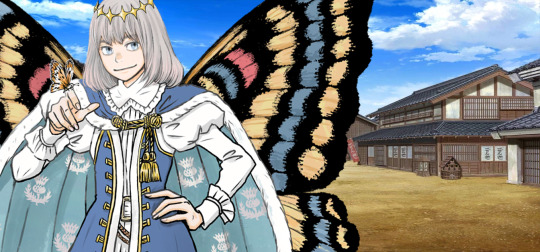
"Sunbeam Row is one of the three metropolises of the Solar Cell, and probably the safest for most Servants and NPCs. The Nameless City is central, but was designed for Grail War conflict- a center battlefield for Servants to duke it out. Sunbeam Row is more of a place of rest, relaxation, and recuperation. I've… slipped away a couple times already when MoonCancer has gotten particularly bossy. I guess you could just say it has a good 'energy' to it."
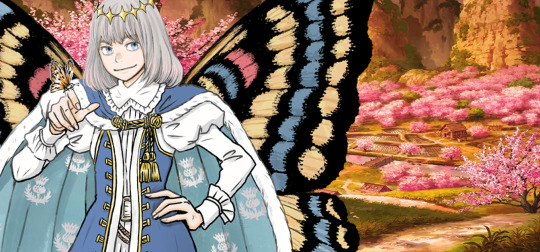
"It's a place of plenty, protected by the blessings of a Lair Servant that declares themselves as manifestations of the Divine Spirit Dakiniten. The NPC's have a saying, that as long as you show respect to the manifestations of the white-faced fox, your travels will be blessed and your needs will be met'. From a combat perspective, it's hard to get a read on them- they seem to avoid conflict whenever necessary, and nobody exactly wants to be the ones to disrupt the peace of such a peaceful place. Gunner did some scouting out there, and ran into one of the 'manifestations', out on the field, picking flowers, and was told…"

"Thank you for fighting, Azure Gunner, the Solar Cell is grateful for your presence."
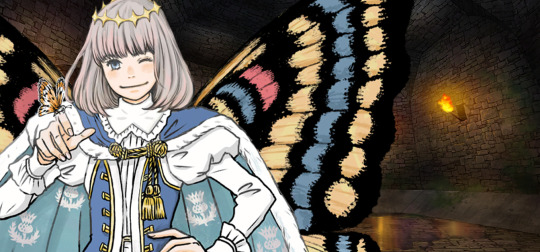
PRETENDER: "He said that the Servant he encountered didn't seem like much of a fighter, though based on discussions of local NPCs, it was like running into one 'face' of the Lair Servant. They say sometimes she's imperial and graceful, sometimes she's quick-witted and easygoing, and sometimes she's amicable and giving... so on, so forth. Omnipresent, benevolent... I don't know much about goddesses, frankly, but people talk about her like she's a ruler from a fairy tale."
13 notes
·
View notes
Text

Fox Lore 🦊
All around the earth, there are stories of tricksters, messengers, and guides.
The fox is one of those creatures that are quite custom to Japanese (Yōkai kitsune), Chinese (Huli jing), Vietnamese (Ho Tinh) and Korean (Kumiho) folklore…as servants of the gods and as omens of death and destruction.
In early Mesopotamian mythology, the fox is one of the sacred animals of the goddess Ninhursag. The fox acts as her messenger.
This is similar to Shinto mythology, the foxes are the divine messengers of the Kami spirit Inari (specifically-Ukanomitama-no-Kami and the Inari Gods (Fushimi Inari).
In Japanese kitsune mythology, foxes are gifted with an ability called: kitsunebi (Fox Fire).
Kitsune refers to both real foxes and fox spirits, or rather every fox can become a fox spirit, and they can have many powers.
Kitsunebi refers to a phenomenon of strange glowing orbs that appear in a row which are thought to be little balls of fire breathed out by kitsune, or foxes, to light their way. If there are many lights in one area, it is said that there is a fox wedding taking place.
Kitsune also possess another quality commonly associated with foxes - shapeshifting and mental manipulation. In most lore involving foxes shapeshifting, the fox will transform into a beautiful young woman who seduces men, but they can sometimes be dangerous: like Tamamo-no-Mae.
Kitsune shapeshifters are not always seen as malicious however, the Inari Foxes and Byakko are seen as good foxes that will help, guide, lead, live with humans, possess humans to help them and serve as messengers of the Inari Goddess, Ukanonitama.
In fact, there are actually 7 Kitsunes in Japanese Lore:
(1) One of the well know Kitsune’s is Byakko 白狐(Reiko 霊狐) is a white furred vulpine spirit that is mostly benevolent. In Japanese mythology, the legend tells of the Seimei Abeno’s (安倍 晴明) mother Kuzunoha (葛の葉) who was, in fact, a Byakko that transformed into a women. This gave Abe great abilities in divinity.
In Shinto, the Torai people of the Korean Peninsula believe their goddess, who protected foxes, would later evolved into becoming Ukanomitama, the chief deity of Inari who settled on the ‘Fox Mount’ (Near Kyoto), also called Byakko.
Most of the high noble foxes of Ukanomitama are called: Myōbu. Japanese folklore contains several stories that suggest explanations for the connection, mainly involving Fushimi Inari-taisha on Mount Inari near Kyoto City.
On this sacred ‘spirit’ mountain are a vast number of Inari shrines, most of which are devoted to the Inari Cult and the 5 Inari Gods, but some are also devoted to other deities and ascended humans, including a fox deity named Myōbu.
Fushimi Inari-taisha itself contains a number smaller shrines dedicated to foxes, including the Byakko-sha (white fox shrine) and the Myōbu-sha (court lady shrine). The fox messengers of Inari Ōkami are also called Byakko, Myōbu, and Inari Foxes.
The Hindu-Buddhist influenced introduced the Great White Fox who brought the goddess Dakiniten [荼枳尼天] to Japan. It is believed that the legend of Dakiniten began the ‘human-fox’ hybrid appearance of divine foxes as it is said Dakiniten and Inari had a human/fox-form.
There are also 2 sub-types of Byakko: the Shikigami Izuna [飯綱] and the Kudagitsune [管狐].
(2) the Yako [野狐] are one of the most depicted in animes and arts—wild foxes.
They are usually depicted with a leaf on their forehead. Unlike the divine Byakko, Yako still possesses their physical state and are often delinquents with their sole concerns of how to use their shape shifting ability is to trick or frighten naive human only for their self-gratification, instead of helping them.
Yako are never worshipped in any form, and are not Inari Foxes. In fact, many Inari Foxes are tasked in hunting for Yako Foxes to bring back into the fold.
Most Yako seem to live in the Kingdom of Izumino (Osaka, Japan); nearby to the old Capitol city of Kyoto where the Byakko live.
(3) the Kinko [金狐] & Ginko [銀狐] are the incarnations of Yin-Yang dualism, Kinko & Ginko are two in one as an unity.
While Kinko is the manifestation of Yin representing the Sun, Ginko, on the other hand, is the manifestation of Yang representing the Moon.
Not a whole lot are known about them in detail, Japanese Folklorist Kunio Yanagita (柳田 國男) classifies them under the term ‘Zenko’ (善狐), a classification of Byakko spirit.
The statues of Kinko’s holds a key in its mouth and are worshipped for financial wealth; the Ginko’s statue holds a scroll in its mouth and is worshipped for academic success.
(4) the Kurogitsune (黒狐) or also called a Genko (玄狐) is a black furred fox that incarnated into a Big Dipper. These foxes are also Inari Foxes.
Before becoming a manifestation of a constellation, Genko was an ordinary black fox that served under the Shinto agricultural deity Ukanomitama as it migrated to Northern Japan.
The Genko lead Fox was sent to guard Princess Hatsuhime, who lived in the North. When she died of illness; the Genko remained in the north with his family.
(5) one of the most powerful and dangerous kitsunes’s is Kyubiko [九尾狐] or also spelled Kyubi-no-kitsune [九尾の狐]. They are white furred vulpine spirits with 9 tails.
In fact, many Asian mythologies include many-tailed (1-9 tails), shapeshifting foxes.
Typically, such fox spirits gain a new tail, and increase their power, every 100 years until they reach the full nine. Only the ninth tail can be given by the gods (as in Japanese mythology). Thus, the number of tails is an easy shorthand for how old and powerful an Asian fox spirit truly is.
One of the most powerful Kyobiko Foxes greatly influenced the Yin Empire by transforming into a princess named Dájǐ (妲己). When they discovered what she was, Warlord Wǔ Wáng [武王] murdered her, bringing and end to the Yin Empire.
Being a powerful kitsune, though her body was destroyed; her spirit transformed into Lady Tamamonomae [玉藻前], the high concubine of Emperor Toba [鳥羽天皇] during the Heian Era. Lady Tamamonomae was first featured in classic Japanese literature as a supernatural character who got executed by soldiers after they uncovered her being a Kyubiko in "Tamamonomae-monogatari" [玉藻前物語] written during the Kamakura Era.
There, Tamamonomae became the Killing Stone of Nasu, her spirit entrapped and destined to one day be freed when the world was on the brink of chaos. In 2021; the Killing Stone split in two, releasing Tamamonomae.
There is a 8 tailed variant of Kyubiko called a Yaonokitsune. The Yaonokitsune is a kitsune that was forgotten until a story regarding the Fox was discovered in 2015, in Kyoto.
In the story, Yaonokitsune appeared in General Iemitsu Tokugawa’s [徳川 家光] (1623-1651) dream on his sickbed, and prophesized that his illness would soon be cured. His health was improved after possession and the Fox then departed back to Inari.
(6) The Kuko [空狐] is one of the oldest Kitsune’s and can be considered divine or godly.
Kukos are millennium old, non-physical entities comprised solely of pure divine energy. More specifically, they possess an immense parapsychological power such as telepathy, prophecy, and remote viewing.
One story of a story of a Kuko involved a man named Genjiro Nagasaki [長崎 源次郎] who was possess by a Kuko that lost its carnal body after being killed by a dog when traveling from Western Japan to Edo City.
Kuko, not only cured Genjiro's neurosis, but also gave him divine knowledge on historical battles during the Sengoku Period. Before its departure, Kuko explained to Genjiro that it decided to possess him because he was a righteous man and also left a signature together with this story by calling itself "Tenbi" [天日] as an alias.
(7) Lastly, we have the Tenko [天狐] that is identical to the Kuko Kitsune.
Tenko are divine, non-physical vulpine spirit that is over a millennium years old. In the Chinese scripture "Genchu-ki", a vulpine spirit that ascended to the Heavens after absorbing enough ‘ki’ from beautiful, young women for a millennium would turn into a Tenko.
However, in Japanese scriptures, Tenkos are often related to animals, other than foxes, as it’s name implies.
In the Japanese Mikkyo [密教] division of Shingon Buddhism [真言宗]: Tenko refers to a hawk, whereas Chiko [地狐] referring to a dog, despite of having the kanji character for "fox" (狐) in their name.
On Ojika Island, located just off the western coast from Nagasaki Prefecture, is a mythological entity called Tenkoo [テンコー] which is believed to possess people; granting them with prophetic abilities. Biology Historian Teiri Nakamura [中村 偵里] commented on Tenko stating that it could also be synonymous to Ryujin [龍神] (a Dragon Deity) from how Tenko is occasionally referred to as ‘Shinko’ [辰狐] (which, is also an alternative name for Dakiniten, the Fox goddess).
In Korean mythology, the dangerous Fox is the Kumiho; though there is also a lesser known fox spirit named Cheonho, which is a divine animal spirit that supposedly protects kings.
The Cheonho has golden fur and possess the gift of clairvoyance. It to can split it’s one tail into nine pieces (instead of nine tails).
In Chinese mythology, there is the Huli jing can be either a good or a evil spirit. Like the kitsune and the kumiho, huli jings are shapeshifters, and often assume the forms of beautiful young women.
The Chinese believed that they were entirely made up of feminine energy (yin or jing) and needed to gather masculine energy (yang) to survive. This leads to acts of seduction and possession.
The Moche people of Peru once worshiped animals and often depicted the fox in their art who was a warrior who used mental attacks in warfare.
In Greek mythology, Teumessian fox always evaded its hunter. According to the myth, it was sent by a god, possibly Dionysus, to punish the city of Thebes for a crime the people had committed.
Since Thebes was under the protection of Zeus, he sent the foxes mortal enemy: a dog named Laelaps who continues to hunt Teumessian in the constellations.
In the Celtic realm, as the Celts and Scots believed the fox was to be a guide, and was honored for its infinite wisdom. The Celts understood that the fox knows the woods intimately, and they would rely upon the fox as their guide in the spirit world.
In Ireland, there is an old Irish superstition warns men about meeting a red-haired woman early in the morning for she might be a fox in disguise.
In Finnish mythology, the Fox is also depicted as a cunning trickster, but is seldom evil.
In Northern Finland, the Fox takes to the heavens to conjure the ‘revontulet’ which translates into ‘Fox Fires’.
The fox is said to conjure the aurora borealis while it runs through the snowy hills of Finland. When the fox’s fur touches the snow, it creates mystical sparks that sets the sky ablaze.
In Germany & France, there is Reynard the Fox. Reynard is an anthropomorphic Fox the is a trickster.
He's well enough known in France that the entire Fox species was renamed after him
From Bulgaria and Russia, there is the myth of Kuma Lisa, a female fox who is a cleaver trickster.
Kuma Lisa encountered Kumcho Vulcho, a wolf, who suffered from her tricks and games.
In North America, Native American mythology has two interpretations for the fox: (Northern tribes) observes the fox as a wise and noble messenger. (Plains tribes) views the fox as a trickster playing pranks, or worse luring one to demise. Similar to Coyote in the Pacific Northwest Coast.
In an Apache myth, people were given fire by Fox.
As the story goes, the Fox decided to steal fire from the fireflies to help warm up the world. He learned how to fly from geese to go to where the fireflies lived and kept fire to themselves.
Lighting a piece of cedar attached to his tail, he managed to run off with sparks flying everywhere, and eventually, fire reached the people.
In Inuit Mythology; they believe the Fox can speak and are believed to be able to remove their fur and become a human woman.
These female shapeshifters like to play tricks on humans and to live with humans.
Like the Selkie, if their skin is taken, they will be unable to transform back into their Fox form.
In the Dogon mythology of Africa; the Pale Fox is a trickster god of the open desert. It is the embodiment of chaos; but also the messenger of the gods (similar to Japanese Inari Foxes, and the Mesopotamian goddess Ninhursag foxes).
In Tswana, there is a riddle that goes:
"Phokoje go tsela o dithetsenya”
Meaning: Only the muddy fox lives. It is similar to the philosophical sense that only an active person who does not mind getting muddy, gets to progress in life.
Honorable Bad Foxes:
Dogon Trickster God - Pale Fox
India/China/Japan Nine Tail Fox - Tamamo-no-Mae
Vietnam Hanoi Fox - Hồ tinh
333 notes
·
View notes
Text
This is the last chapter, the full story is now up!
Takashi wears his new omamori on the walk to the train station. It feels like being in a shrine, but gentler. Sensei doesn’t have to scare any yokai away. Everyone just— Acknowledges Takashi respectfully. Some yokai stare at him, curious, and some look hungry. But they don’t lunge at him or try to eat him, even if they clearly want to. They know he’s protected.
Takashi knows that if he reaches out to any of them, to talk to them, they won’t be afraid of him. He knows if they need his help, they won’t be afraid to ask him. He feels safe, wearing the omamori, and he must feel safe to them, too.
“I’m sorry Inari and Dakiniten didn’t like your omamori,” Takashi says to Natori-san. He knows Natori-san and Tanuma-san worked very hard on it.
“I consider it an honor to have my work insulted by the gods,” Natori-san says. “My worst critics are my biggest fans.”
“Keep telling yourself that,” Nyanko-sensei smirks.
“You’re one to talk,” Natori-san snipes back. “The gods had to do your job for you, too.”
Nyanko-sensei growls at Natori-san, and Natori-san glares daggers at Nyanko-sensei.
Takashi finds their squabbling reassuringly normal.
6 notes
·
View notes
Photo
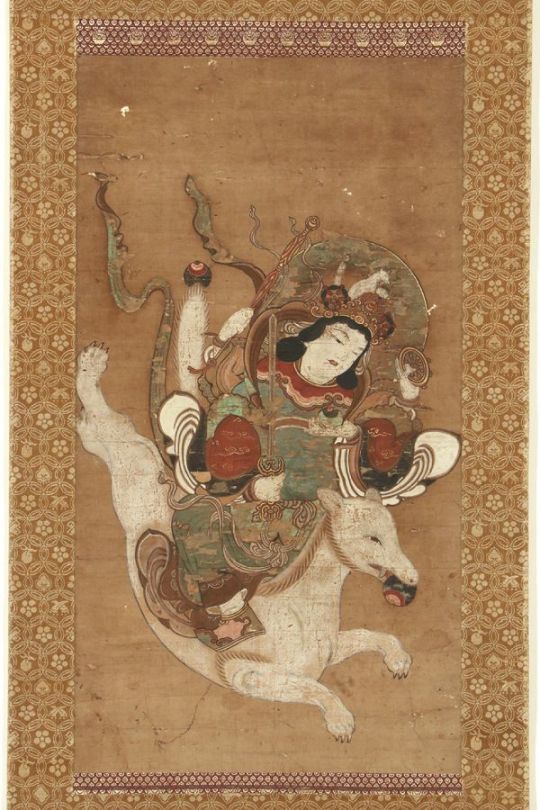
A hanging scroll of the goddess Dakiniten (荼枳尼天) at Tōfukuji Temple (東福寺) in Kyoto, invoked generally for prosperity and fecundity, grasping a treasure rod and dharma wheel with her upper hands and a wisdom sword and wish-granting jewel with her lower hands,
Color on paper dating to the Muromachi period (1336-1573), attributed to the artist Kichizan Minchō (吉山明兆) (1352-1431), a.k.a. Chōdensu (兆殿司) or Hasōai (破草鞋)
#japanese art#buddhist art#荼枳尼天#吒枳尼天#茶吉尼天#dakiniten#稲荷#inari#吉山明兆#kichizan mincho#兆殿司#chodensu#破草鞋#hasoai#京都#kyoto#東福寺#tofukuji#tofukuji temple#臨済宗#rinzai#zen buddhism#hanging scroll
39 notes
·
View notes
Text

so the imagery on kuukou’s nb sukajan!!!!!!
these lotus mandalas of course represent enlightenment, but in this specific instance, i believe they are in reference to the the ‘mandalas of the two realms.’ these realms, the diamond and womb realms, come together to basically teach wisdom and and the principles of buddhism. within these realms reside deities and the sanskrit in the mandalas represents a deity in those realms!!!!!


the character that looks like a ‘b’ represents ‘kujaku myoo’ a female wisdom king residing in the diamond realm!!! she is associated with the peacock, which eats insects (like we’ve seen kuukou do in arb lol) so she’s worshipped for removing suffering and misfortunes from others. the other character represents the deity ‘dakiniten,’ another female deity residing in the womb realm!!! she’s one of the handful of gods carried over from indian mythology into buddhism known for protection and blessings.
combining these together, kuukou’s sukajan likely symbolises protection from suffering and misfortunes, as we’ve seen him do a handful of times in canon!!!!
#vee queued to fill the void#*laughing crying screaming* diving off the deep end into buddhism to understand just HOW complex kuukou is is a lot of fun!!!!!!!!#but i feel insane whenever i do lol y’all i dug deep for this one and only paraphrased it 😭😭😭😭#the ‘b’ character can also represent ‘daikokuten’ a deity of fortune and wealth#it was carried over from the god of destruction shiva and tho kuukou is a force to be reckoned with certainly lol#i went with the other deity kujaku myoo because of where she resides and what she represents fits kuukou better#the kujaku in this deity is not to be confused with kuujaku posse lmao (tho if you wanna talk about voids and buddhism i can—)#ah and wisdom kings are in a sense off shoots of buddhas!!!!#they’re known for their fierceness and wrath towards impurities that cause suffering#and if hypstage ever wants to let sasara and kuukou in on the king of kings glory that should also be theirs#i have been SAYING kuukou would declare himself a wisdom king!!!!!!!#c: kuukou👑
13 notes
·
View notes
Text
So, Asuka’s Cyber Angels. Before we talk about them, we need to talk about the Cyber Girls first.
The original Cyber Girls were EARTH Warriors focused on Fusion, and Tribute Summoning. Their presence in the greater Cyber archetype was obviously a reference to Asuka’s connection to Ryo (this connection is reminded on Ryo’s end by Cyber Pharos, a later support for Cyber Dragons). Their designs, and effects were largely a homage to Mai’s Amazoness cards, which become relevant in the context of GX(Tania), and ARC-V (Tyler Sisters).
But everybody knows, after the duel with Titan, Asuka realizes Fusion is not the way to go, and adopts Titan’s Ritual Summoning to her own. Her Main Deck Cyber Angel is now based off retrains of early Fairy-Type monsters, with her new secondary mascot, Cyber Petit Angel, being a retrain of Anzu’s Petit Angel. And since she now cares about Judai now, her monsters shift to being references to Judai’s monsters, and cards instead of Ryo’s.
****
For Cyber Angels we need to need to divide them separate them into three groups, the GX ones, the ARC-V ones, and the post-ARC-V ones. The GX ones, and the ARC-V ones are largely based off Buddhist gods, whereas ARC-V ones are based off Hindu gods, since ARC-V already has tons of Buddhist references.
****
For GX ones:
**Cyber Angel Benten’s Kanji name, 弁天, Benten, references Benzaiten (shortened as Benten), the Japanese Buddhist version of the goddess Hindu goddess, Saraswati, consort of Brahman the creator god. The Kanji 弁 either means petal or speech (similar to Melodiouses’ naming pattern I guess?), and 天, ten, means heaven, but is used as the suffix for standard Kanji naming of Buddhist gods.
Benten’s effect’s reference is one of the most obvious. It is the same as Flame Wingman (and base, non-Pendulum Odd-Eyes Dragon), but with DEF instead of ATK.
**Cyber Angel Idaten’s Kanji name, 韋駄天, Idaten, references Idaten, the Japanese Buddhist version of Skanda, a bodhisattva that protects Buddhist temples. He is a presumably historical person who is venerated as if he is a god, without actually being one. Idaten is one of the genderbent Cyber Angels, and there is more to come. I don’t know what 韋, means in Japanese Kanji, it is almost always used in reference to Buddhism (though in Classic Chinese it means tanned leather), 駄 means of low quality, but also a packhorse, likely alluding to Idaten’s speed, and we already discussed 天, ten.
Idaten’s effect is a bit more obscure, it is based off Judai’s Skyscraper.
**Cyber Angel Dakini’s Kanji name, 荼吉尼, Dakini, references Dakiniten, the Japanese Buddhist version of Dakini, the female corpse eaters in Hinduism. The Kanji 荼 is used to transliterate Hindu terms, but on its own, it references Ixeridium dentatum (the flower reference again...), 吉, ki, means good luck, and 尼, ni means sister, but here it means Buddhist nun.
Dakini’s effect is probably the most obscure one, it is based off Elemental HERO Plasma Vice, and its ATK/DEF are 100 higher than Plasma Vice, which is supposed to represent that Asuka now surpasses Judai from the past, but Judai at the Season 4 is basically a demi-god, so...
***
As the final comments, the original GX Cyber Angels have more mechanical designs. The later Cyber Angels will have more organic designs. This is likely because original Cyber Angels are meant to be an updated reference to Buddhist self-mummification, with elements of Mary Shelley’s Frankenstein, and The Six Million Dollar Man added in.
***
For ARC-V ones:
*Cyber Angel Vrash’s Kanji name is 美朱濡, Vishnu, references Vishnu, but as I posted earlier, this is a non-standard Kanji. 美, bi, means beautiful, 朱, shu, means vermillion, or red, 濡, nyu, means wet, but can euphumeristically mean sex. As I said in the previous post, this is likely not just a funny dirty joke (though congratulations for ARC-V team passing this sh*t pass the radar), but also references of Fusion used as a metaphor for sex in GX, and ARC-V a la Steven Universe.
Vrash’s statlines reference Judai’s Neos Wiseman, and Vishnu’s fused form with Lakshmi, Vaikuntha Kamalaja, is likely the connection with Yubel. Its Extra Deck monster destruction effect references the upper tier Neos Fusions (Chaos Neos, Storm Neos, Rainbow Neos), and its effect activation negation effect references White Night Dragon, Asuka’s boss monster from her brainwashed Duel against Judai in GX Season 2.
Vishnu is shown generally with a lotus (allusion to Yuzu’s Bloom Aria, and Yubel’s Samsara Lotus), and four arms (allusion to Mieru’s Tarotrei).
*Cyber Angel Natasha’s Kanji name, 那沙帝弥, Nasateiya, references Nasadiya sutta, though the monster itself references Kalki. The Kanji is non-standard. The Kanji 那, na, means what or which, and it is used in replacement of the Kanji 奈, which is used in Buddhist concept of Naraka(basically Hell), 沙, sa, either means sand, or one in 100 million, 帝, tei, means sovereign, but in the context of Yu-Gi-Oh! it means Monarch, and 弥, ya, means either go across/cover, widely, extensively, increasingly, or for a long time/forever. So it means something like “What does the Sand Monarch cover?” or “How long will Sand Monarch last?”, as I said before, the Sand Monarch here is likely Leo, since Duel Academia is a fortress built on a Pacific Island, his empire is literally, unironically built on sand.
Natasha’s LP drain effect is likely based off Judai’s Draining Shield, its attack negation effect is likely based off Negate Attack (abused by Judai back in GX), and the control switch effect is a likely reference to Judai’s Mirror Gate. Its statlines reference Judai’s lesser Level 5 Fusions.
Natasha’s artwork features a weird Valkyrie armor, either as a allusion to Siegfried’s Valkyries, or to Mai’s Dunames Dark Witch, or Yuzu’s Valkyrie monsters (Solo, Bloom Prima). Her mask is based off OG Supreme King’s Evil HERO Infernal Gainer’s mask, it is almost a perfect copy.
***
The ARC-V Cyber Angels don’t use standard Kanji, instead go for punny names. Their more organic designs also deviate from original Cyber Angels, though that is expected, since that is the case for all returning archetypes in ARC-V.
The main reason of existing here is because they were not printed back in GX era, so they got printed with the new support. But also Ben Kanji in Benten’s name likely created a connection with Yuzu’s Melodious, with the “sound is flowers” pun going there. As such, Asuka’s ARC-V monsters more closely resemble Melodiouses (and to lesser extent Mieru’s Prediction Princesses), than Ryo’s Cybers, or Judai’s Elemental HEROes.
Natasha’s design basis, Kalki, is also references Reira’s role in the ARC-V finale as the Kalki of Ray, in addition to reference of Asuka being Yuzu’s temporary salvation, and metafictional predecessor.
****
Post-ARC-V one:
*The only one here is Cyber Angel Izana’s Kanji name is 伊舎那, Ishana, is based off Hindu god Ishana (which is believed to be one of the avatars of Shiva), which is adopted in Japanese Buddhism as Ishanaten. Interestingly Izana’s design seem to be based off Ishana’s consort in Japanese Buddhism:
https://en.wikipedia.org/wiki/Ishana
Īśānī is Īśāna's consort. According to the Secret Storehouse Records (祕藏記) she is flesh white in color and wields a spear.
For why she is named as Izana, as a reference to Izanami/Izanagi in TCG:
According to the Ainōshō, there is a theory that this deity is synonymous with Pāpīyas as well as the Shinto deity Izanagi. The Jinnō Shōtōki also states that there is a theory that the names of Japan's primordial creator gods Izanagi and Izanami are the same as the Sanskrit names Īśāna and Īśānī.
The Kanji 伊, I, doesn’t mean anything on its own (though it means something like you or this in Classic Chinese), 舎, means house or inn, 那, na, is the same as above. So I guess it means something like “Is this your house?”, even though it is meant to be the classic transliteration of Ishana.
This card’s statlines, and effect is based off Idaten, though its multiple attack is based off Elemental HERO Wildedge. Interestingly, this card is more of a parallel to Serena’s Lunalight Leo Dancer, since it was released in same set as its reprint (Duelist Legend 4/Sisters of the Rose). Card destruction effects are based off Idaten, but they might also be inspired by Glow Neos, who also wields a spear.
***
Bonus speed round: Machine Angel cards and Ritual Sanctuary:
*Machine Angel Ritual’s Kanji name is 機械天使の儀式, Kikaitenshi no Gishki, which literally means Ritual of the Mechanical Angel. 機械, kikai refers to the Kanji name of Machine-Type, but literally means Mechanical/Tool, 天使, means tenshi, angel (as in the Fairy-Type), の, no, means of, 儀式, Gishki, means Ritual.
*Machine Angel Absolute Ritual’s Kanji name is 機械天使の絶対儀式, Kikaitensei no Zettaigishki, which literally Absolute Ritual of the Mechanical Angel. The only new Kanji is, 絶対, zettai.
*Incarnated Machine Angel’s Kanji name is 応身の機械天使, Oujin no Kikaitenshi, features 応身, which means nirmanakaya, a concept in Buddhism that means:
https://jisho.org/search/%E5%BF%9C%E8%BA%AB
nirmanakaya (response body, form taken by a buddha according to the capabilities of those who are to be saved)
So it can be translated as Mechanical Angel’s Response Body.
*Merciful Mahine Angel’s Kanji name is 慈悲深き機械天使, Jihibukaki Kikaitenshi, 慈悲深き is a corruption of 慈悲深い, jihibukaku, which means merciful. The suffix き, ki means past tense, so this means Formerly Merciful Mechanical Angel, because the artwork shows Izana in Buddha pose, so this is you, the player, encountering Izana in the Samsara cycle after death. 慈悲, Jihi, literally means compassion, but it refers to Buddhist concept of Karuna. 深, is read as bu here, but actually is spelled fu, and means deep (though it can be apparently read as shin, ie. death).
*Magnificent Machine Angel’s Kanji name is 荘厳なる機械天使, Sogon’naru Kikaitenshi. 荘厳, sogon, can mean grim, stern, sublime, or solem, and なる, means to attain or to become/transform. So it means something like Mechanical Angel Attaining Solemnity.
*Ritual Sanctuary’s Japanese name is 祝福の教会-リチューアル・チャーチ, Shukufuku no Hikai - Richuaru Chachi. The Katakana, リチューアル・チャーチ, is Ritual Church. 祝福, Shukufuku, literally means blessing, but specifically refers to blessings from God in Christianity, 教会, Hikai means church, but specifically refers to Christian Church. So it means something like Church of Holy Blessing - Ritual Church. Peak American Protestantism right here.
****
Other things of note:
*Integration of Shinto-Buddhist-Hindu gods might confuse you, but don’t worry, vast majority of major Shinto Gods are believed to be originating from Hindu Gods, with others being later Chinese additions. Local Gods are largely disconnected from this, though, obviously.
*Isao’s Idaten the Conqueror Star is written in Katakana (覇勝星イダテン, Hashousei Idaten, Victory Star Idaten, lit. Conqueror Victory Star Idaten). This Idaten is written in Hiragana.
*Something I didn’t talk about in the Melodious post, the ha/ka (flower) Kanji used in Melodious is also found in terms relating to ascension/Samsara cycle, which likely ties into whole “Eternal Recurrence” concept that ARC-V uses, which Nietsche adopted from Buddhism/Hinduism/Asian mythologies and their connection to Indo-European myths in general. Because you know, the pendulum swings and back forth, and a theatre play is repeated the same way always with slight differences etc. There is a lot more going on there, since that is the fundamental thesis statement of the show, this is going to be a recurring theme (ha!) in ARC-V related archetypes. (It is also present GX Season 3, and Aporia’s pieces, but both GX, and 5D’s reject circular time theory. ARC-V, on the hand, goes full ham with it.)
Edit: Miswriting, it is Mirror Gate, Mirror Wall is Mai’s card.
5 notes
·
View notes
Note
thank you for the reply and the information! I was curious how the other fox would fit in with PCB Extra's metatextual mention of Three Lands, but I hadn't even considered it might be three worlds and not three countries. this is neat
(Original post for context)
I forgot I left the response to this in my drafts, sorry. Luckily, this means I could update it with recently acquired knowledge when I found it again.
Truth to be told, my point is less that the other fox is a better match, and more that Ran being Tamamo no Mae is one of these things which make sense at first glance, but the deeper you look into it, the less coherent it becomes.
This got much longer than I planned, so for organizational purposes let's refer to this post as Revenge of the "graveyard god", or why I don't think Ran is Tamamo no Mae. More under the cut.
The early Tamamo no Mae
The main point of connection between Tamamo no Mae and Ran are the nine tails, but that’s not even really a consistent part of the former's background. The oldest version of the story - which is really fun, the seduction section is pages upon pages of Tamamo and emperor Toba discussing esoteric Buddhism - states that she was “an 800-year-old two-tailed fox from the Nasuno Plain in Shimotsuke Province”. Early depictions of her true form follow this pretty closely:

Nezu Museum of Art, via Monsters, Animals, and Other Worlds. A Collection of Short Medieval Japanese Tales
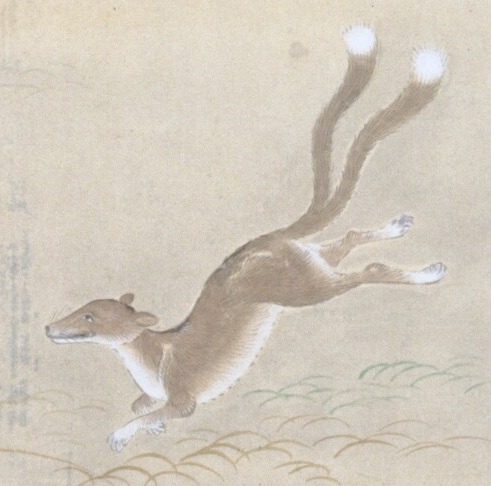
Kyoto University Rare Materials Digital Library

Suntory Museum of Art
As far as I am aware, the two tails are actually unique to her. Other foxes of note have either one tail or nine. While it does seem the belief in the number of tails growing with age is genuine rather than a modern misconception, it’s hardly central to fox folklore (I’ve seen the portmoneu “foxlore” at least once btw, it’s very funny). And, as I will outline later, it doesn’t even seem to be behind the idea of nine-tailed foxes in the first place.
Anyway, the oldest version does provide Tamamo with more backstory, but it’s closer to presenting Shuten Dōji as a manifestation of Mara than to a straightforward “Tamamo is x under a pseudonym” popular today. As we learn, the two-tailed fox is in fact a reincarnation of a “graveyard god” (塚の神, Tsuka no Kami) from India, described in the apocryphal Humane Kings Sutra (it gets namedropped directly), likely originally composed in China.
How come? It all started when Kalmashapada, a prince of Devala in India, wanted to offer 1000 skulls of virtuous rulers to this deity because a suspicious “heretical” preacher convinced him it’s a good idea. After defeating and imprisoning 999 such kings, he encountered Shrutasoma, one of the previous incarnations of the historical Buddha, who managed to show him the error of his ways. All of the kings were released, and Kalmashapada was redeemed.
The “graveyard god” was less than thrilled, and swore to keep reincarnating as a fox in kingdoms where Buddhism flourished to destroy it. We are told that happened many times, but only one past identity, that of Bao Si (Hōji), comes up. Obviously, eighth century BCE China was not exactly an area famous for Buddhist devotion, but that’s irrelevant here. We are told the endgame is not just to overthrow a righteous ruler, but also to become his replacement. Alas, Tamamo no Mae obviously fails at both of these goals. Still, points for trying.
The story does not provide the deity with a specific identity. However, Nobumi Iyanaga notes that in the referenced sutra he’s Mahakala (the original Makakaraten version, not the joyful Daikokuten). In East Asian Buddhism he is described as dwelling in the graveyards due to acting as both the chief of dakinis and their subduer. At the same time, Iyanaga argues in the context of the Tamamo no Mae story it can be argued he is either implicitly replaced by the dakini par excellence, Dakiniten (closely associated with foxes), or that the deity has no identity other than the fox one.
Later Tamamo developments
Two elements which are mainstays of modern retellings are missing from the oldest version, as you might have noticed. It doesn’t feature the Sesshōseki, which was only added later, seemingly as a way to promote Zen Buddhism, since this extension of the story casts a member of this school as the new protagonist. In the early variants Tamamo’s corpse was brought to the imperial treasury, the same one which shows up in a similar context in the tale of Shuten Dōji, and there is no indication she came back as a vengeful ghost, let alone that she repented and accepted Buddhism, as she does in some of the Sesshōseki variants.
The other difference is, as I already pointed out, the tails. The oldest depiction of a nine-tailed Tamamo no Mae I am aware of is Sekien’s. Based on a few papers I read it would appear textual variants of the story giving her nine tails might have been in circulation earlier, but that’s not reflected in any of the illustrated scrolls shown above.

Sekien's nine-tailed Tamamo (wikimedia commons)
Sekien claims that Tamamo no Mae is one and the same as Daji (I’ll get back to her later), and specifies the latter was a nine-tailed fox. He cites Zhang Dingsi’s Langye Dai Zui Bian (浪挪代醉編, “Langye’s Substitute for Drunkenness: A Compilation”) as his source for this tidbit, but does not explain where does the conflation of the two foxes come from. In contrast with the elaborate reincarnation scheme from the older version, he states Daji simply flew across the sea to reach Japan, without reincarnating.
What is now essentially treated as the “definitive” version of the Tamamo no Mae story, and what cemented her image as a nine-tailed fox, only dates back to 1805. That’s when Ehon Sangoku Yōfuden (絵本三国妖婦伝; “Tales of Enchantresses in the Three Kingdoms”) finished publication. The author, Ranzan Takai (高井蘭山), was an enthusiast of neo-confucian thought, and he wanted to write a story highlighting the time honored confucian belief that dynasties are brought down by suspicious concubines. The real goal was somewhat broader, though -the story of Tamamo no Mae was essentially repurposed as a critique of the concept of women playing an important role in public life.
It needs to be noted here that it is not impossible that the original was already part of a political polemic. Arguments have been made that Tamamo is a fictional representation of Bifukomon-in, for instance. They are certainly linked to the same emperor, Toba.

Bifukomon-in (wikimedia commons)
However, while I would not rule this out altogether, it’s hard to deny the typical medieval penchant for reinterpreting Buddhist material feels more central to the story. It is ultimately a very elaborate twist on the Humane Kings Sutra first and foremost. It belongs to the same world as other fabulous tales about figures from distant Buddhist lands arriving in Japan, alongside the likes of the legend of emperor Suwa of Hadai or the medieval Amaterasu narrative involving Mara (stay tuned for my post about that one).
Ideological motivations aside, in Ranzan’s version an anonymous nine-tailed fox appears as Daji in China, Kayō in India (seemingly a leftover of the original “graveyard god” story; here the prince is convinced to carry out his evil plans by his concubine instead though), and finally Tamamo no Mae in Japan. He also gives a unique account of Tamamo’s arrival in Japan, as far as I am aware: in his novel, she was brought there by Kibi no Makibi, a famous historical envoy to China. This was not his first time as a literary character, a much earlier picture scroll about his adventures is pretty funny (I have Touhou ocs based on it), but I’ll save this discussion for another time.
Not quite Tamamo: the influence of Daji
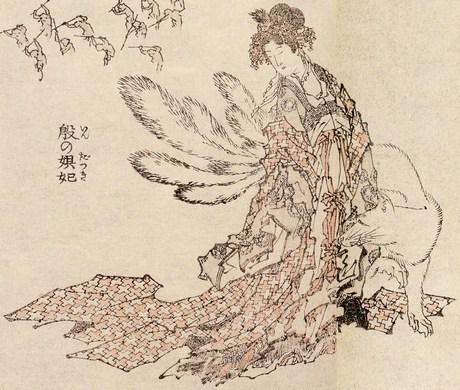
Daji, as depicted by Hokusai (wikimedia commons)
Daji requires some further discussion. She was initially regarded simply as a non-supernatural wicked concubine, but came to be treated as a fox posing as a human by the Song period. According to Xiaofei Kang the oldest evidence for that comes from 1101, from a Japanese text presumably reflecting an already extant Chinese belief. By the Yuan period it became a commonly accepted view, with Quanxiang Pinghua (全相平話) specifically stating Daji had nine tails. Her fox-like image was finally cemented fully by popular novels in the Ming and Qing periods.
Since there was a preexisting tradition in which Daji was a human woman, a remedy was developed: the “real” Daji was possessed by a fox, who took her name and identity. Curiously, the fox component of her story is otherwise not very important, and some modern authors basically characterize it as “tacked on”: she is the quintessential evil concubine bringing kingdoms to ruin out of a sense of cruelty who just happens to be a fox, and her story doesn’t really depend on preexisting fox-related motifs.
There are multiple accounts of Daji’s deeds, but the most famous one, and at the same time the most likely influence on Razan’s portrayal of her (and thus Tamamo), is Investiture of the Gods. However, he skips the origin attributed to her here: in the Chinese original, Daji is an agent of the goddess Nuwa, though she eventually overdoes it and is rebuked by her former boss for excessive cruelty. This doesn’t really fit well with Tamamo’s backstory, obviously; making her and Daji interchangeable was detrimental to both characters, I feel.
A Chinese story dealing with Daji reincarnating does exist, but it’s not exactly similar. In the Ming novel Zhaoyang Qushi (昭陽趣事) she reincarnated as Zhao Hede, a concubine of emperor Cheng of Han. What happens next has been described as “pornographic entertainment enlivened by supernatural and historical costumes”. For more details, check out Rania Huntington’s book from the bibliography below.
Curiously, it is possible Daji was simultaneously an object of active cult, since there is a Song imperial edict outlawing the shrines dedicated to her, Wutong (a southern Chinese spirit who was believed to bring wealth and bewitch people, compared with foxes in the north) and “General Shi” (no clue who that might be, I’d hazard a guess one of the popular pacified vengeful spirit cults but don’t quote me on that). However, another contemporary source instead mentions the outlawing of temples of “fox kings”, so it might also mean that the name of Daji was applied by officials to an unrelated popular fox cult (“fox king” is a reasonably common appellation for supernatural foxes). Both regular and nine-tailed foxes are attested in such a context across history.
Early nine-tailed foxes

An early Chinese depiction of a nine-tailed fox (wikimedia commons)
The early portrayals of nine-tailed foxes are something I started looking into recently because of Ran’s freshly revealed connection to Yuuma: I figured it makes sense that she’d be in origin someone who belongs to the same world as the taotie.
Looking at the earliest Chinese sources, multiple nine-tailed foxes appear in legends about virtuous rulers like Tang, Wen or Yu the Great, essentially as generic good omens, without much fanfare. According to confucian commentaries from the Later Han period, the nine tails were understood as a sign a given emperor will have many descendants. The exception from this generally positive tendency is the Classic of Mountains and Seas, where the nine-tailed fox is described as “man-eating” (something very uncommon in Chinese fox literature). However, it also doesn’t exactly get more spotlight than the other creatures. It’s also treated as a separate animal from regular foxes, not as a particularly old fox. You could say it is to the fox what a bai ze is to an ox, I think.
Visual arts add further specimens: the source of this discussion, the nine-tailed fox attendant of Xi Wangmu, later seemingly “decanonized”, and another belonging to the entourage of Zhong Kui. Both of these are hardly eminent and seem to fit the mold of auspicious omens. In Zhong Kui’s case the fox is in one case listed alongside the bai ze which only strengthens this impression. However, it also makes sense that its inclusion would reflect Zhong Kui’s role as a demon queller: he is often portrayed with conquered demons as servants, after all.
Conclusions

To sum up: ultimately it just doesn’t seem nine-tailed foxes are quite as big of a deal as popculture makes them seem, and nine tails are neither exclusive nor innate to Tamamo no Mae. Since that’s the only real point of connection between her and Ran save for a throwaway PCB line which leads to no further references, I maintain there’s no strong case for identifying them with each other, especially since there is no shortage of other candidates.
There’s also the fact that, Daji aside, most other nine-tailed foxes are largely blank slates you can do anything with, while Tamamo has many fairly unique characteristics which would be wasted by randomly slapping her name on Ran, in my opinion. To be fair, ZUN does occasionally make similar mistakes - Yoshika is the main example (remember, the actual legend about Yoshika’s immortality claims he decided to pursue eternal life after having a thrilling affair and has him call himself “strongest madman under heaven”).
I would personally argue ZUN himself probably did not feel strongly about who Ran is supposed to actually be when he originally came up with her, though. None of her spellcards reference Tamamo no Mae. Or any other fox identified with her, for that matter. They do have a more or less consistent theme, but that theme is, broadly speaking, “magic arts”, from onmyodo (Shikigami "Banquet of the Twelve General Gods"), through shugendo (Illusion God "Descent of Izuna-Gongen", Shikigami "The Protection of Zenki and Goki", Superhuman "Soaring En no Ozunu") and esoteric Buddhism (Shikigami "Channeling Dakiniten", Esoteric Sign "Odaishi-sama's Secret Key"), to contemporary stage magic (Shiki Brilliance "Princess Tenko -Illusion-"). In other words, I do not think canon actually strongly supports any specific option.
I will admit I’m biased but personally I think picking a different fox makes it much easier to accommodate Yuuma and their shared animal realm past, the most thrilling Ran development in ages. As for Tamamo, I do think she would be fun to see in Touhou, but preferably as her own character - with two tails, if possible.
Bibliography
Bernard Faure, The Power of Denial. Buddhism, Purity, and Gender
Rania Huntington, Alien Kind. Foxes and Late Imperial Chinese Narrative
Nobumi Iyanaga, Under the Shadow of the Great Śiva: Tantric Buddhism and its Influence on Japanese Mediaeval Culture
Idem, Dākinī in: Brill's Encyclopedia of Buddhism (vol. 2)
Xiaofei Kang, The Cult of the Fox: Power, Gender, and Popular Religion in Late Imperial and Modern China
Laura K. Nüffer, Lady Tamamo in: Keller Kimbrough and Haruo Shirane (eds.), Monsters, Animals, and Other Worlds. A Collection of Short Medieval Japanese Tales
Sumiko Sekiguchi, Gender in the Meiji Renovation: Confucian 'Lessons for Women' and the Making of Modern Japan
Chun-Yi Joyce Tsai, Imagining the Supernatural Grotesque: Paintings of Zhong Kui and Demons in the Late Southern Song (1127-1279) and Yuan (1271-1368) Dynasties
34 notes
·
View notes
Note
Holmes' components theory! I do believe the gods Zeus feared most beside Prometheus are the Moirai (Big sis Atropos, Middle sis Lachesis and Little sis Clotho), Nyx and of course his "beloved" wife Hera. Vairocana might be his 2nd component like you said since Koyanskaya refer Holmes as her nemesis probably because of the Amaterasu=Vairocana=Dakiniten=Inari=Toyoukebime=Uka no Mitama thìng
oooh i did see some bringing up Nyx but i was confused as to why in the first place (because having a component like this implies a Creator nature even more pronounced which holmes does have with the shadow border and all but i will gladly agree for the Stargazer part but to me i need to see it connect the way Itzpapalotl isn't an outside in douman's saint graph because of their focus on parental relationships and targeting sons and mothers)
YES YES YES it's probably synchretism issue once more...
there's too much possibilities for 2 components that it kills me...i just wish we would know already
1 note
·
View note
Note
If Kiyomori is summonable, i want him to refer Tamamo as "Dakini-san" and Tamamo says "No, you're wrong. I'm not Dakini". (also let him have the divinity of Dakiniten)
Which ones is....oh that guy? Yeah even I know that story! He was a big deal?! ........OH ITS KAKEGIYO'S LEADER? Hell yeah bring em on! More Kagekiyo content is good content! Doubly so if we get Ammy!
1 note
·
View note
